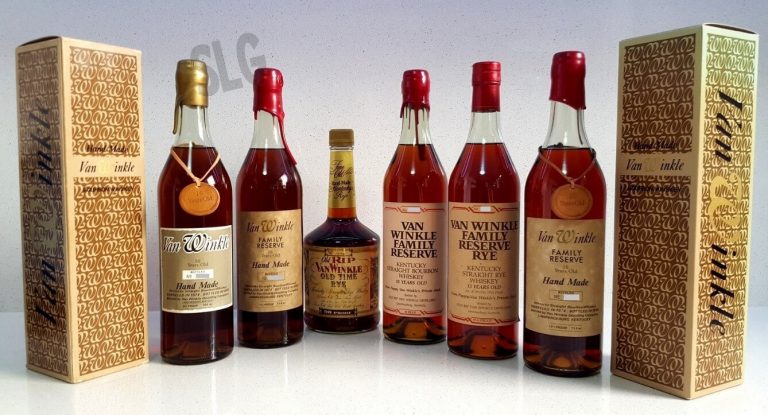The Pappy Van Winkle phenomenon has exploded in the past decade which has seen prices go the same way as age-statement Japanese whisky – through the roof and with very limited supply and huge demand dictating no end in sight.
If you’ve ever been confused on how to date Pappy bottles and make sense of their dot matrix codes, and if you’ve ever wondered when the green glass bottles were released and when the wax top bottles went out of production etc, then look no further. 😉
When we began researching how to read the dating codes on various Pappy bottles throughout the decades, we came across some brilliant information from whiskyid.com. They perfectly deciphered the Van Winkle coding strategy with defined clarity which suited our whiskey infused brains to a tee. Hopefully the following helps you as much as it helped us.
From whiskyid.com
Date Codes
Dating Van Winkle bottles post-2007 is made relatively easy based on “laser codes” or “dot matrix codes” printed onto the bottles. These codes indicate the bottling line, date, and time the bottle was filled, but can sometimes be difficult to find and/or read. The date codes are usually printed on the back of the bottle below the label, though occasionally they’re above the label or under the label itself. A bright flashlight shining though the bottle from the other side will often aid in finding the code.
There are three versions of the date code layout, each with its own decoding schema:
Pre-2012: K2250910:22
In this example, the K = the bottling line, 225 = the 225th day of the year, 09 = the year bottled, 10:22 = the time bottled in military time.
2012 and on: B1312011:11K
Here, the B = Buffalo Trace, 13 = 2013, 120 = the 120th day of the year, 11:11 = the time bottled in military time, K = the bottling line.
2017 and on: L18189011019D
Here we have the following, L stands for “Lot Code”, 18 = 2018, 189 = 189th day of that year, 01 = represents the plant where it was bottled (Buffalo Trace, Frankfort), 1019 = the time bottled in military time, D = bottling line
Prior to 2007 Buffalo Trace wasn’t using Date codes, so it’s a little tougher. You can see the timeline for more clues.
Timeline:
-1983- Julian Van Winkle III started bottling at the Hoffman Distillery in Lawrenceburg.
-1989- Old Rip Van Winkle 15-year-old was released.
-1991- Van Winkle Special Reserve Lot A was released (one release only), followed by Lot B.
-1994- Pappy Van Winkle 20 year was released in light green glass bottle, rye recipe bourbon.
-1997- Van Winkle Family Reserve Rye 13 was released, preceded by the 12-year Old Tyme Rye. Rumoured to be Medley-distilled.
-1998- Pappy Van Winkle 23 year was released in light green glass and rye recipe bourbon.
-1999- Pappy Van Winkle expressions changed to using clear glass bottles.
-2002- With the merger, the operation moved to Buffalo Trace. Whiskey bottled prior to the move is labelled “Lawrenceburg, KY” and after the move, “Frankfort, KY.”
-2004- Old Rip Van Winkle 15 year was discontinued and replaced with Pappy Van Winkle 15 year. The letters and numbers on the ORVW15 bottles are reportedly not an indicator of bottling age. ORVW squat bottles generally have a number molded in the glass at the bottom of the bottle however. Also, in 2004, the Van Winkle Family Reserve Rye was tanked after having continued to age despite being labelled as 13 years old. It was rumoured to have been mingled with Cream of Kentucky (Bernheim) rye. See timeline graphic below for more info.
-2005- The last regular-production wax top Pappy 23 was released, with an “A” number and Frankfort on the label.
-2007- Buffalo Trace bottling lines started using dot matrix codes on their bottles.
-2009- The 114 proof Old Rip Van Winkle 23-year decanter set was released in the fall, limited to 1200 sets.
-2010- No Pappy 15 was bottled this year. All 15 sold during 2010 was bottled in 2009.
-2012- Dot matrix code format switched to new layout. Also, the 10 year/90 proof version was discontinued, leaving only the 10-year, 107 proof.
-2013- The Old Rip Van Winkle 10 year started using the tall cognac-style bottle like all the other expressions. Prior to that, ORVW 10 used the short, stout bottles. The spring release was cancelled in lieu of only a larger fall release henceforth.
Other tips
There’s one other clue to the dating of Pappy Van Winkle: raised lettering on the label. The words “Pappy Van Winkle’s Family Reserve” were embossed into the label so they protruded until around 2006, when a new label style was introduced that used flat labels.
So, there you have it friends. Hopefully this leads to some educated buying and discussions when drinking with fellow whiskeyphites.
The Old Barrelhouse
